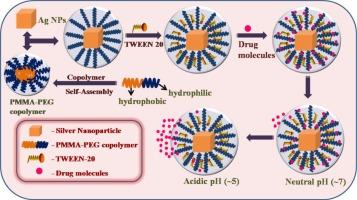Role of biocompatible PMMA-PEG@Ag nanocomposite in the specific delivery of doxorubicin and resveratrol
IF 4.2
Q2 CHEMISTRY, MULTIDISCIPLINARY
引用次数: 0
Abstract
Doxorubicin (DOX) is the most widely employed chemotherapeutic drug, despite it is frequently associated with severe adverse effects. Resveratrol (RES) is a polyphenolic stilbene derivative found in red wine and grapes, and it is well known for its antioxidant properties. Numerous reports have been proved its excellent potential in anti-inflammatory, anti-aging, and cancer-treatment. Among various cancer deaths, an appealing solution to this might be the targeted distribution of DOX, combined with such natural biomaterials via nanoscale level drug carriers. Earlier, we have reported PEG-PMMA copolymer based nano-carriers that could delivered curcumin only to tumours in a pH-dependent manner and yield an enhanced therapeutic impact. In this connection, here we have proposed a PMMA-PEG@Ag nanocomposite to deliver these natural and commercial drugs (RES and DOX) towards the harmful human tumours. Powder X-ray diffraction (XRD) and scanning electron microscopy (SEM) in conjunction with various spectral techniques were used to investigate its morphology, size (nano-cube like structure around ∼2 nm) and other physical properties. Their potential toxicity towards HEK293, A549, and HeLa cancer cell lines was investigated via 3-(4,5-dimethylthiazol-2-yl)-2,5-diphenyltetrazolium bromide (MTT) assay and also the half maximal inhibitory concentration (IC50) values were determined from the MTT assay. The observed in-vitro results revealed that they are effective nanocarriers for biological medications. Furthermore, this PMMA-PEG@Ag nanocomposite loaded with two medicines (RES and DOX) has displayed amazing pharmacokinetic and pharmacodynamic behaviour. Due to their multifunctional properties, this finding may be able to overcome the drawbacks of traditional cancer therapy and open up new therapeutic prospects.

生物相容性PMMA-PEG@Ag纳米复合材料在阿霉素和白藜芦醇特异性递送中的作用
阿霉素(DOX)是最广泛使用的化疗药物,尽管它经常伴有严重的不良反应。白藜芦醇(Resveratrol, RES)是一种在红酒和葡萄中发现的多酚二苯乙烯衍生物,以其抗氧化特性而闻名。许多报道已经证明了它在抗炎、抗衰老和癌症治疗方面的巨大潜力。在各种癌症死亡中,一个有吸引力的解决方案可能是DOX的靶向分布,并通过纳米级药物载体与这些天然生物材料相结合。早些时候,我们已经报道了基于PEG-PMMA共聚物的纳米载体,可以以ph依赖的方式将姜黄素输送到肿瘤中,并产生增强的治疗效果。在这方面,我们提出了PMMA-PEG@Ag纳米复合材料,以提供这些天然和商业药物(RES和DOX)对有害的人类肿瘤。粉末x射线衍射(XRD)和扫描电子显微镜(SEM)结合各种光谱技术研究了其形貌、尺寸(约2 nm的纳米立方体结构)和其他物理性质。通过3-(4,5-二甲基噻唑-2-基)-2,5-二苯基溴化四唑(MTT)试验研究了它们对HEK293、A549和HeLa癌细胞的潜在毒性,并测定了半数最大抑制浓度(IC50)值。体外实验结果表明,它们是有效的生物药物纳米载体。此外,这种PMMA-PEG@Ag纳米复合材料装载了两种药物(RES和DOX),表现出惊人的药代动力学和药效学行为。由于它们的多功能特性,这一发现可能能够克服传统癌症治疗的缺点,开辟新的治疗前景。
本文章由计算机程序翻译,如有差异,请以英文原文为准。
求助全文
约1分钟内获得全文
求助全文

 求助内容:
求助内容: 应助结果提醒方式:
应助结果提醒方式:


